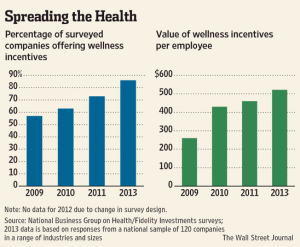Transparency is extremely important to us, so we are letting you know that we may receive a commission on some of links you click on from this page. See our disclaimer.
Wellness programs typically give employees incentives to improve their health — such as quitting smoking, losing weight, or lowering their blood pressure. They might also subsidize employees for gym membership fees, reward them for meeting certain goals, or charging them more for health care insurance if they don't.
 According to the Wall Street Journal, 90 percent of companies now reward workers for participating in some type of wellness program — up from 57 percent in 2009.
According to the Wall Street Journal, 90 percent of companies now reward workers for participating in some type of wellness program — up from 57 percent in 2009.
“That number is likely to grow next year, when rules take effect under the Affordable Care Act that give employers more tools to prod workers into healthier behavior. The law will let companies charge employees who don’t meet certain health targets 30 percent more for insurance premiums, up from 20 percent now,” Bloomberg Businessweek reports.
“Chronic conditions such as obesity and diabetes account for three-quarters of U.S. health costs; a lot of that money could be saved if Americans took better care of themselves. Giving incentives to quit smoking or lose weight, the reasoning goes, will help companies tame growing medical costs while making workers healthier.”
However, the biggest reason companies use wellness programs to save money. Unhealthy workers are not only less productive, they also cost their companies much more in health care insurance rates.


0 Comments